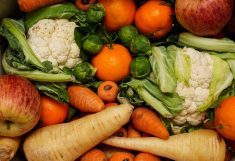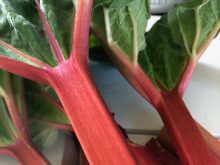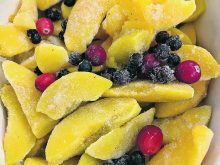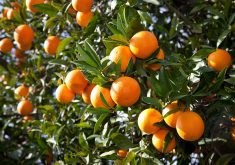Haskap, also called blue honeysuckle or honeyberry, is a recent addition to the Canadian commercial fruit production and garden scene, thanks mainly to the work done by the University of Saskatchewan fruit program.
Bob Bors and his colleagues have worked to combine the best traits from haskap plants collected from across Canada, Japan and Russia.
Their goal is to develop varieties that can be mechanically harvested, have great taste and will bear fruit for an extended period of time.
They have introduced several varieties, including Tundra, a large firm fruit that melts in your mouth and Borealis, which is not as firm as Tundra but is larger and flavourful.
Read Also

Nutritious pork packed with vitamins, essential minerals
Recipes for pork
The Indigo series has several varieties and Honey Bee, which is grown as a pollinator for the other varieties, has a good flavour with a bit of an astringent aftertaste.
With a tolerance to cold temperatures and early fruiting, haskap is suited for northern growing.
Typically, it bears fruits in mid-June, providing the first fresh fruit of the season.
Haskap has a unique flavour that has been compared to a combination of raspberry, blueberry, saskatoon and blackberry. It is a blue oval-shaped berry that has a dusty blue-coloured skin. The skin is delicate and tends to melt in your mouth.
Japanese call haskap the fruit of longevity and vision. The berries are high in vitamins C and A, potassium, fibre and antioxidants.
HASKAP DAY
The University of Saskatchewan will be hosting a haskap day July 20. The event is part of the North American Fruit Explores annual conference July 18 – 21. For more information, visit www.sites.google.com/site/nafexsaskatoon2012/home.
Recipes wanted
DEAR TEAM: I read your column in The Western Producer and wondered if you could print recipes using haskap berries. I would like jam and/or jelly recipes as well as baked items. — Calla Rowan, Sask.
In searching for haskap recipes, I discovered Sarah Galvin’s food blog at allourfingersinthepie.blogspot.ca.
Linda Matthews of the University of Saskatchewan, who was involved in the initial haskap research and development, is another good source.
She said haskap combines well with ice cream and yogurt and would probably make a good addition to a fruit smoothie.
For making pies, she would make a cooked pie filling with berries and sugar and thicken with cornstarch, similar to a saskatoon berry or blueberry pie filling.
Galvin described haskap as tart and a little overwhelming for a pie.
“But once cooked and sweetened, my gosh, they are the most flavourful and amazing berry I have ever tasted,” she said.
Galvin found that haskap has a lot of natural pectin and her jam sets fine without commercial pectin.
SARAH’S HASKAP JAM
- 2 c. frozen haskap 500 mL
- 2 c. sugar 500 mL
- 1/4 c. fresh lemon juice 60 mL
Mix the haskap with the sugar and bring to a boil. Add the lemon juice. Continue to boil until it has reached the jam stage. Skim off any scum that forms. Test your jam on a plate that has been chilled in the freezer. Put a one-half teaspoon (2 mL) of jam on the cold plate and let it cool down. If the mixture does not run when you tip the plate, it is thick enough.
This jam is intensely flavoured and a little goes a long way. Galvin prefers to use the jam in haskap crumble squares rather than on toast.
HASKAP CRUMBLE SQUARES
- 1 1/2 c. unbleached flour 375 mL
- 1 1/2 c. rolled oats 375 mL
- 3/4 c. chopped almonds 175 mL
- 1 c. brown sugar 250 mL
- 1 tsp. baking powder 15 mL
- 1/2 tsp. cinnamon 7 mL
- 1/4 tsp. salt 1 mL
- 1 c. unsalted butter, at room temperature 250 mL
- 1 1/2 c. haskap jam 250 – 375 mL
Preheat oven to 375F (190 C). Grease a nine x nine inch (22 x 22 cm) baking pan. In a large bowl, mix dry ingredients except almonds. Cut in the butter until the mixture is crumbly. Set aside one cup (250 mL) of the mixture for topping.
Press the crumble on the bottom of the baking pan. Evenly spread the jam over the crumble. A thin layer is all you need. Sprinkle with the chopped almonds and then the reserved crumb mixture. Pat down gently. Bake for 30 to 35 minutes until golden. Cool completely before cutting into squares.
Sarah suggested that haskap could probably be substituted into any recipe that uses raspberries or blackberries.
Source: allourfingersinthepie.blogspot.ca.
Poisonous plant information system
If you have ever wondered what would happen if a child or pet ate a particular plant, this website is an excellent resource. The information was designed for use by veterinarians, doctors and poison control personnel but is user friendly and may help you remove or avoid plants before there is a crisis. Visit www.cbif.gc.ca/pls/pp/poison?p_x=px.
For your information
Hort Snacks, a monthly e-newsletter edited by Rob Spencer of Alberta Agriculture, targets direct market horticulture crop producers and those in related industries. www1.agric.gov.ab.ca/$department/newslett.nsf/homemain/snack. For more information, contact Rob Spencer at robert.spencer@gov.ab.ca.
Betty Ann Deobald is a home economist from Rosetown, Sask., and a member of Team Resources. Contact: team@producer.com.

















